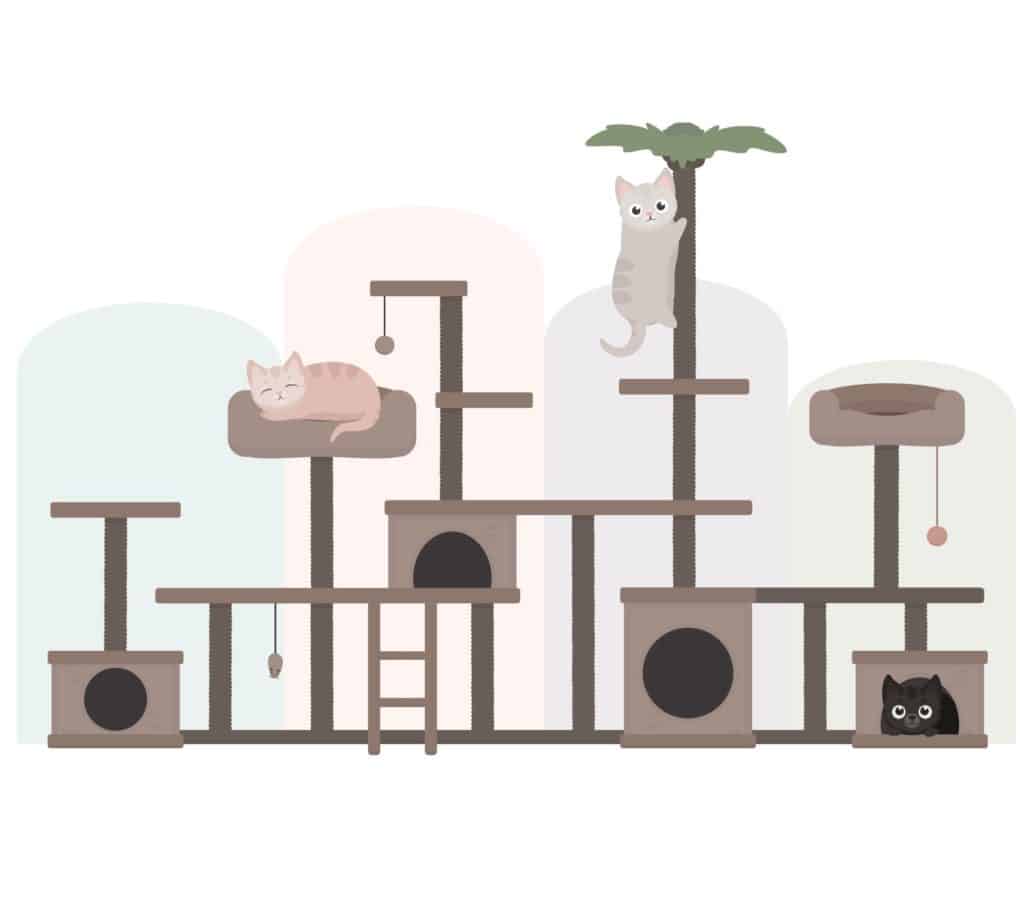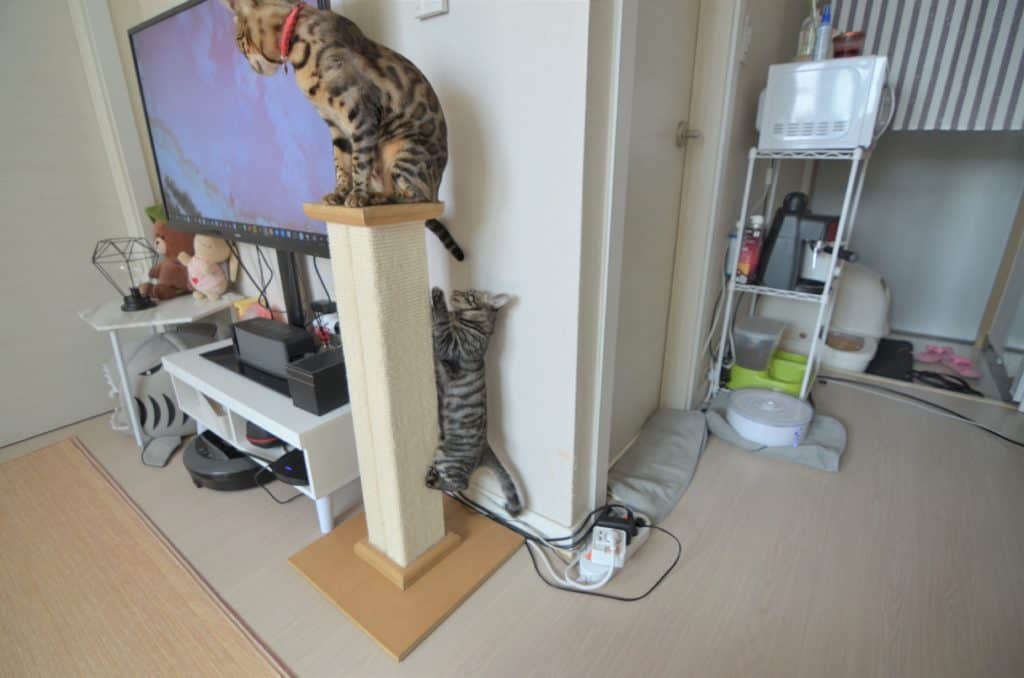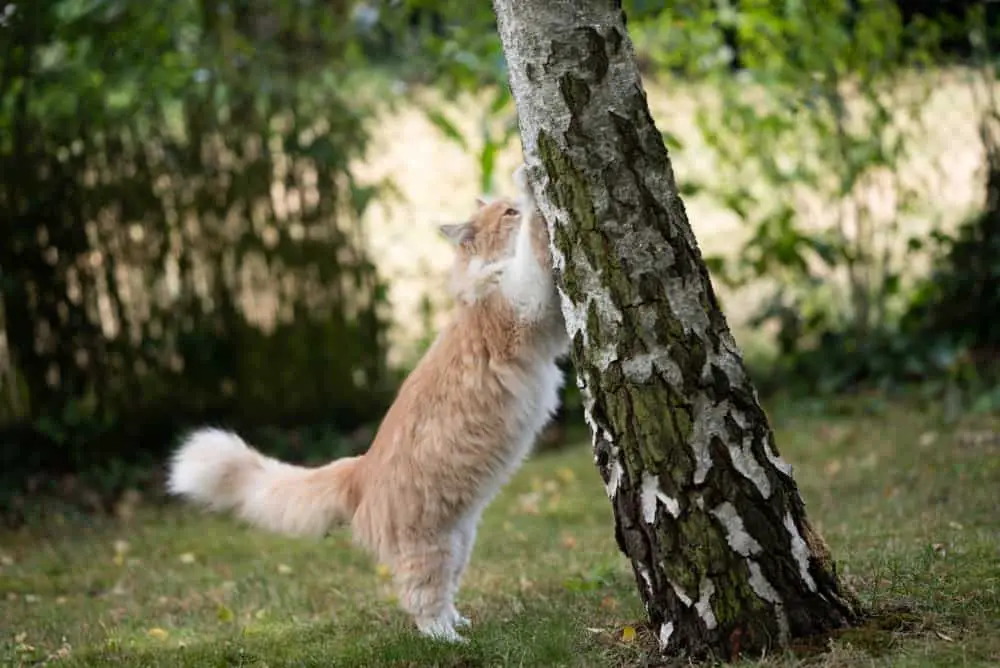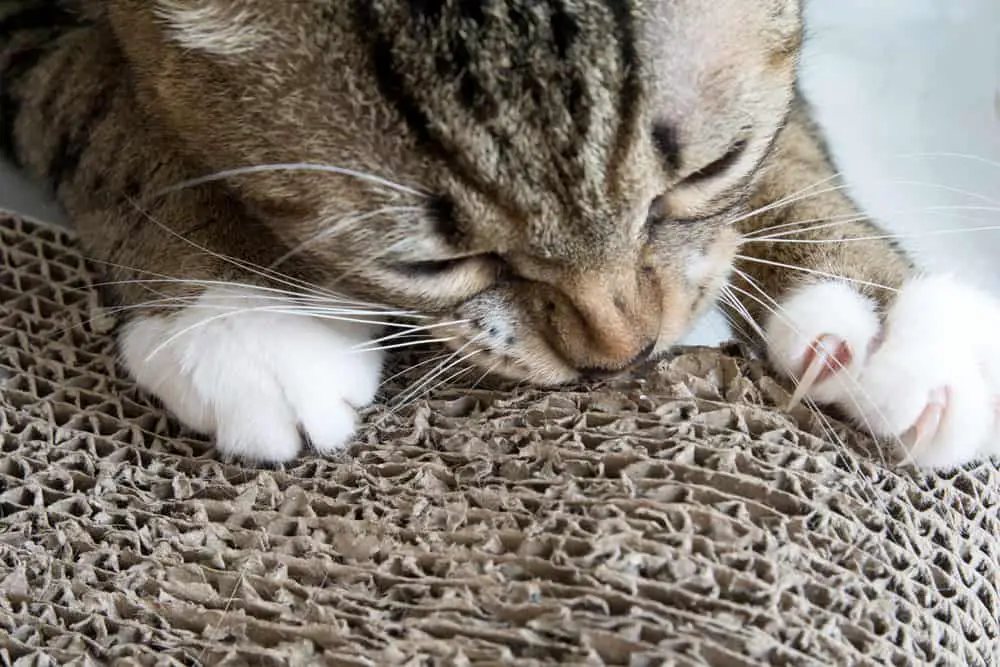Why cats choose to scratch one thing over another is really up to their own individual preferences. It’s similar to asking why you like to use one keyboard over another; different feelings, textures, and materials can affect your decision.
Cats, of course, are no different. They need to scratch, so providing them with a wide breadth of options to scratch is an excellent idea to prevent anything else from being scratched (i.e., your furniture!).
Figuring out the minimum effective number of scratching posts without cluttering your home with unnecessary items is the goal.

The scratching post is a cat staple, and almost every cat owner will have one.
So how many cat scratching posts do you need? The simple answer is 1 scratching post per room that you have plus one extra. This allows the cats to put their scent in each room by scratching the post and allowing you to vary the types of scratching posts/materials available.
Why Are Scratching Posts Important?
These are the main reasons why cat scratchers and scratching posts are important in any cat home:
- Cats scratch to shed the outside layer of their claws to keep them sharp:
Cats are always prepared to hunt at any time – so even indoor cats will constantly scratch to keep their claws sharp.
Cat claws are one of their self-defense mechanisms. Without their claws, they can become stressed and develop other health issues. - Cats scratch to put their scent (from their glands in the paws) on the item:
Cats are also very territorial and their confidence comes from knowing their environment. The best way of knowing their environment is through scent.
The litter box, scratching post, their toys, where they lay on, all of these are scent markers for the cat to know their surroundings.
If you have a cat bed that one cat has been laying in for a long time and you try to put another cat in there, they will probably refuse and push away.
Scratching posts and scratching items are second in terms of scent markers – the first being the litter box. Spreading these scent markers around gives your cat a sense of familiarity within the home as opposed to putting these items right next to each other. - Cats use it for vertical progression, elevation, and play:
Cats use the scratching post as a perch a lot. They love to just sit there and observe things around them. If the perch is tall enough, it allows them to access different places that are even higher around the home.
Some horizontal cat scratchers doubles as a play area – allowing your cat to both use it for play or to scratch.
Having multiple functions to your scratching post is crucial to minimize the amount of stuff you have in your home.

Recommended # of Scratching Post Chart
The number of scratching posts you should have should be 1 per room in the home plus one. As a side note, everyone has their own ways of providing a scratching area – this is just what works in my experience to minimize any negative scratching behaviors.
For me, figuring out the minimum effective number of scratching posts is important because although we want our cats to be satisfied, we also don’t want to cover our whole home with scratching posts (for those living in small apartments like I am).
| # Rooms (1n+1) | Number of Scratching Posts | Comments |
| 1 | 2 | In one room, put the scratching post in a high traffic area of the room. Preferably in different spots/zones of the room. There is little point in having two scratching posts side by side. I recommend varying these two scratching areas with one vertical scratching post and one horizontal/angled scratching post. |
| 2 | 3 | In 2 rooms, put the 2 scratching posts where there is the most furniture. Try to vary the scratching post that you choose. Choose a staple vertical one but make sure to have different angled scratching posts too for variety. In the other room, you can experiment and maybe try a different type of material or scratching post to provide some extra options for your cat. |
I think you get the idea.
The key is to spread out these scratching items – especially to high traffic/socially important areas that cats can leave their scent.
Usually, these places have a lot of traffic or different animals/people that might mix in with the scent. So having a scratching item there allows the cat to leave their scent within these areas, thus feeling more secure in their surroundings.
What Types of Scratching Posts Do Cats Like?
There are two scratching post types that I would recommend most homes have – it’s at least having one tall vertical scratching post and one horizontal/angled one.
Why have two different types? Some cats just love to stretch out their bodies and lean on a tall scratching post, and other cats love to dig into a horizontal or angled scratching board.

If you observe your cats, you will get an idea of what types of scratching surfaces they prefer.
Most of my cats love to scratch on vertical surfaces in my apartment, except one cat that has taught me the lesson of not assuming that all cats like that same thing. My Russian Blue loves scratching horizontal/flat surfaces.
Therefore, I needed to get something that was angled or horizontal for him to scratch on (and spare my sofa).
Note: whatever scratching post or item you might get, make sure it is stable and can support your cats. Cats are careful creatures, and if it tips over, they will be wary of scratching the post again.
For a great vertical scratching post that my 4 cats have used for over a year (coming on two years!), read the review here: The Ultimate Scratching Post Review!
For other great scratching posts and products that I recommend in an apartment, visit this page: Recommended Cat Supplies.
What Sort of Materials Do Cats Like to Scratch?
Cats will scratch any materials that give them a little resistance when they scratch it. The more different textures we can give them to scratch, the better.

This includes:
- Sisal rope
- Carpet
- Cardboard sheets
- Wood/Uncovered wood
- Thick cloth or weaves
- Felt or other similar fuzzy materials
Including as many types of materials in your home that can be scratched minimizes the number of destructive scratching habits that they might develop in the future.
Quick Tips for Cat Scratchers
However, one thing to mention is to try to avoid materials similar to the furniture you’re using currently. For example, if your furniture has a lot of linen or weaves, avoid getting that type of cat scratcher.
Or, if you have many wooden items in your home that you don’t want to be scratched – avoid wood materials for cat scratchers.
Avoid scratchers (or any cat furniture, actually) with multiple colored threads if you can help it. When cats scratch on it, different colored threads can make the scratcher look old and ragged quickly. One solid color makes it look much better – even through multiple years of use.
Conclusion
In conclusion, knowing the exact number of cat scratchers in a home allows us to plan out and have more effective space for our cats and ourselves.
Also, with the combination of getting the right number of scratching posts/items in the home, varying the scratching post and materials – it’s easy to guide our cats into scratching the right things.
If you’re curious about what types of cats scratch the least or the least likely to have bad scratching habits, read my article here: Cat Breeds That Don’t Scratch Furniture!
